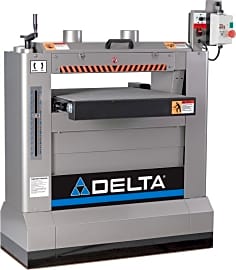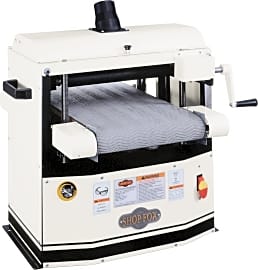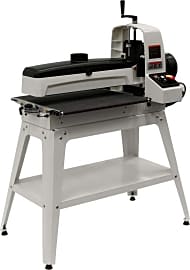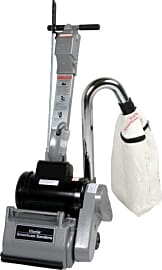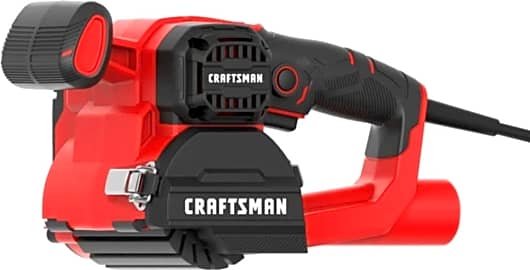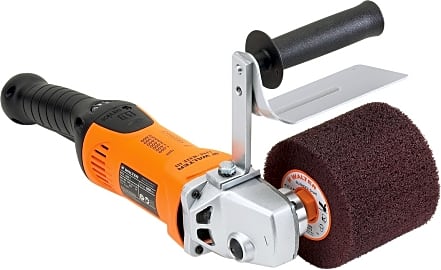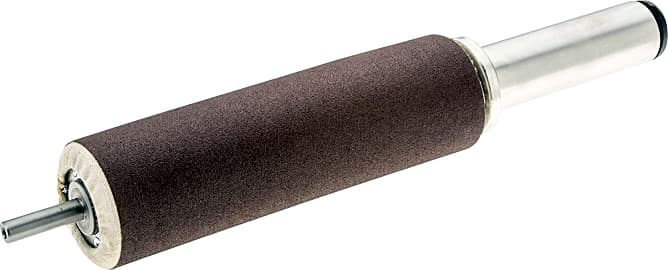The 10 Best Drum Sanders

This wiki has been updated 36 times since it was first published in October of 2016. Drum sanders have a rotating cylinder coated with an abrasive surface, and are used to smooth wooden planks for hardwood floors, or other stock for furniture and cabinets. The fast operating speed allows them to work quicker than manual or even drill-powered options. Our picks considered factors like general build-quality, ease of use, affordability, and adjustability. When users buy our independently chosen editorial choices, we may earn commissions to help fund the Wiki.
Editor's Notes
February 12, 2021:
Traditionally, drum sanders are rather large pieces of equipment with a conveyor table that automatically feeds the workpiece through the sander. However, in this ranking, we also selected a few handheld models, such as the Shop Fox D4595 and the Craftsman Restorer that provide versatility and allow for sanding of irregular shaped items.
In this update, we replaced the two options from Jet with more modern and more versatile models. The Jet JWDS-2244 is a high precision, floor-standing unit that boasts a smart control that monitors the load on the drum motor and automatically regulates the speed. The Jet JWDS-1020 is a benchtop model that offers most of the same features as the JWDS-2244, just in a more compact and portable size. The Grizzly Industrial G0716-10 is a notable addition to the list as its built-in table has wheels and handles that allow it to be quickly repositioned and set up in a new location.
August 15, 2019:
The Powermatic PM2244 was upgraded to first because it is very well built. It has nice rollers, feed tables, and the motor is built to provide service for many years. The side opening allows woodworkers to quickly sand large pieces if the stock is properly supported.
We added the Grizzly G1079R because it is a solid drum sander that is reasonably priced. Even though it doesn't include feed tables, the conveyor assembly is long enough, along with the pressure from the rollers, to evenly work the surfaces of your stock.
Sanding creates fine wood dust that is hazardous if inhaled. Breathing protection should be used to avoid harmful effects.
Why You Really Need A Drum Sander
A drum sander is designed for putting on the finishing touches, not stripping away several layers of stock in one go.
We know, we know — you look around your garage and think that the last thing you need is another power tool, especially one as big and bulky as a drum sander. However, if you don't have one, you're going to end up working way harder than you need to when it comes time to gussy up that wood floor or table.
You may also be thinking that you don't need one if you already have a planer. That's an easy mistake to make, as the two machines seem to do the same thing, but they're very different in practice.
A drum sander is designed for putting on the finishing touches, not stripping away several layers of stock in one go. Trying to be over-aggressive with a drum sander will likely only give you a bunch of burned sandpaper and blown fuses for your efforts.
That said, a drum sander can still accomplish quite a bit in a relatively short amount of time. It's a heavy-duty machine that's able to make wide passes over large surfaces, which is why it's mainly used to resurface floors.
That's not all it's good for, however. There are also bench-style drum sanders, which are great for feeding doors, cabinets, and other large pieces through. These are more versatile than floor models, but again, you'll be limited to bigger jobs.
This is why drum sanders are often only used by professional carpenters, but that doesn't mean that the home woodworker won't often find a need for one. When you do need it, it can save you hours of backbreaking sanding, making it more than worth its price (and the space it takes up).
Ultimately, it's up to you whether you do enough large-scale work to justify pulling the trigger on a purchase. However, just know that it's the type of machine that's a real lifesaver on those times you find a use for it.
Also, when have you ever talked yourself out of buying a power tool?
Choosing The Right Drum Sander For You
If you've decided to bite the bullet and purchase a drum sander, there are a few questions you need to answer first.
The first consideration is what you'll be using it for. If you're doing a lot of floor resurfacing, then you'll definitely need a floor model (funny how that works). If, on the other hand, you're working on furniture, then pick a bench model instead.
From there, decide on how much space you're willing to sacrifice to this thing.
Unfortunately, there aren't really any good options if you're looking to do both, as it turns out it's extremely difficult to pick up a floor and shove it through a bench sander. They do make handheld options that might be able to work, but that would likely be more trouble than it's worth.
From there, decide on how much space you're willing to sacrifice to this thing. Bench sanders can be truly massive, weighing hundreds of pounds and taking up a huge amount of room. Floor sanders aren't much smaller, but at least they're only as big as your average vacuum cleaner instead of a small cow.
Speaking of vacuums, figure out how many dust ports you want as well. The more you have, the cleaner your work area will be when you're done — but you'll likely pay more up front.
Some of your decisions will be purely based on personal preference, and you may want to test a few machines before making a purchase. Things like how easy it is to swap out paper, how much horsepower you really need, and the smoothness of the feed should all be taken into consideration.
Whichever model you choose, though, you'll likely be glad you have it when a big job comes along.
Tips For Using Your New Machine
Now that you've got a fancy new toy to play with, it's time to learn some dos-and-don'ts for getting the most out of your machine.
You should invest in an extension cord that's the same gauge as your sander's cord. Many other cables aren't sturdy enough to handle the amount of juice the machine sucks down, and if you're not careful, you could have a melted cord on your hands (and floor).
Try to avoid your trim, baseboards, doors — everything that isn't floor, basically.
While you're shopping, it's smart to buy a wide assortment of sand paper grits. Finding the right grit will go a long way towards ensuring the job is done correctly, and as quickly as possible. You'll likely want to start with a heavier grit and work your way down to finer options as you go.
Also, this is where we insert the standard reminder to wear a dust mask and safety glasses.
When using the sander, remember that you have a powerful machine in your hands — let it do all the work. You don't need to push down on it to improve its performance, so save your back.
While sanding, go in the opposite direction of the drum motion. This means that, if you have a floor sander, you'll be pulling it rather than pushing it. This can seem counter-intuitive to many people, so it's better to know it ahead of time.
However, you'll want to go with the grain of the wood. Try to keep it in a straight line, just as you would if you were mowing your lawn. Try to avoid your trim, baseboards, doors — everything that isn't floor, basically. It's easy to damage these items with a drum sander.
From there, it's just a matter of watching your progress. The great thing about drum sanders is it's easy to see the difference they're making, which should encourage you to keep working once you notice your progress.
Of course, it's also easy to see when you mess up — but you're not going to let that happen, are you?



